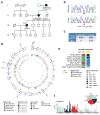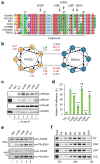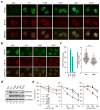Compromised BRCA1-PALB2 interaction is associated with breast cancer risk
- PMID: 28319063
- PMCID: PMC5519427
- DOI: 10.1038/onc.2017.46
Compromised BRCA1-PALB2 interaction is associated with breast cancer risk
Abstract
The major breast cancer suppressor proteins BRCA1 and BRCA2 play essential roles in homologous recombination (HR)-mediated DNA repair, which is thought to be critical for tumor suppression. The two BRCA proteins are linked by a third tumor suppressor, PALB2, in the HR pathway. While truncating mutations in these genes are generally pathogenic, interpretation of missense variants remains a challenge. To date, patient-derived missense variants that disrupt PALB2 binding have been identified in BRCA1 and BRCA2; however, there has not been sufficient evidence to prove their pathogenicity in humans, and no variants in PALB2 that disrupt either its BRCA1 or BRCA2 binding have been reported. Here we report on the identification of a novel PALB2 variant, c.104T>C (p.L35P), that segregates in a family with a strong history of breast cancer. Functional analyses showed that L35P abrogates the PALB2-BRCA1 interaction and completely disables its abilities to promote HR and confer resistance to platinum salts and PARP inhibitors. Whole-exome sequencing of a breast cancer from a c.104T>C carrier revealed a second, somatic, truncating mutation affecting PALB2, and the tumor displays hallmark genomic features of tumors with BRCA mutations and HR defects, cementing the pathogenicity of L35P. Parallel analyses of other germline variants in the PALB2 N-terminal BRCA1-binding domain identified multiple variants that affect HR function to varying degrees, suggesting their possible contribution to cancer development. Our findings establish L35P as the first pathogenic missense mutation in PALB2 and directly demonstrate the requirement of the PALB2-BRCA1 interaction for breast cancer suppression.
Conflict of interest statement
The authors declare no conflict of interest.
Figures



Similar articles
-
BRCA1-Dependent and Independent Recruitment of PALB2-BRCA2-RAD51 in the DNA Damage Response and Cancer.Cancer Res. 2022 Sep 16;82(18):3191-3197. doi: 10.1158/0008-5472.CAN-22-1535. Cancer Res. 2022. PMID: 35819255 Free PMC article. Review.
-
PALB2 is an integral component of the BRCA complex required for homologous recombination repair.Proc Natl Acad Sci U S A. 2009 Apr 28;106(17):7155-60. doi: 10.1073/pnas.0811159106. Epub 2009 Apr 15. Proc Natl Acad Sci U S A. 2009. PMID: 19369211 Free PMC article.
-
Whole-exome sequencing and targeted gene sequencing provide insights into the role of PALB2 as a male breast cancer susceptibility gene.Cancer. 2017 Jan 1;123(2):210-218. doi: 10.1002/cncr.30337. Epub 2016 Sep 20. Cancer. 2017. PMID: 27648926
-
Prevalence of BRCA1, BRCA2, and PALB2 genomic alterations among 924 Taiwanese breast cancer assays with tumor-only targeted sequencing: extended data analysis from the VGH-TAYLOR study.Breast Cancer Res. 2023 Dec 14;25(1):152. doi: 10.1186/s13058-023-01751-z. Breast Cancer Res. 2023. PMID: 38098088 Free PMC article.
-
Homologous recombination and human health: the roles of BRCA1, BRCA2, and associated proteins.Cold Spring Harb Perspect Biol. 2015 Apr 1;7(4):a016600. doi: 10.1101/cshperspect.a016600. Cold Spring Harb Perspect Biol. 2015. PMID: 25833843 Free PMC article. Review.
Cited by
-
PALB2 (partner and localizer of BRCA2).Atlas Genet Cytogenet Oncol Haematol. 2018 Apr;22(12):484-490. doi: 10.4267/2042/69016. Atlas Genet Cytogenet Oncol Haematol. 2018. PMID: 31413733 Free PMC article.
-
BRCA1-Dependent and Independent Recruitment of PALB2-BRCA2-RAD51 in the DNA Damage Response and Cancer.Cancer Res. 2022 Sep 16;82(18):3191-3197. doi: 10.1158/0008-5472.CAN-22-1535. Cancer Res. 2022. PMID: 35819255 Free PMC article. Review.
-
Refinement of the assignment to the ACMG/AMP BS3 and PS3 criteria of eight BRCA1 variants of uncertain significance by integrating available functional data with protein interaction assays.Front Oncol. 2023 Apr 24;13:1146604. doi: 10.3389/fonc.2023.1146604. eCollection 2023. Front Oncol. 2023. PMID: 37168384 Free PMC article.
-
Association between single nucleotide polymorphisms of DNA repair genes (BRCA1, BRCA2, and PALB2) and breast cancer incidence in a subset of Iranian population.Hered Cancer Clin Pract. 2025 Mar 29;23(1):12. doi: 10.1186/s13053-025-00311-0. Hered Cancer Clin Pract. 2025. PMID: 40158114 Free PMC article.
-
Computed cancer interactome explains the effects of somatic mutations in cancers.Protein Sci. 2022 Dec;31(12):e4479. doi: 10.1002/pro.4479. Protein Sci. 2022. PMID: 36261849 Free PMC article.
References
-
- Xia B, Sheng Q, Nakanishi K, Ohashi A, Wu J, Christ N, et al. Control of BRCA2 cellular and clinical functions by a nuclear partner, PALB2. Mol Cell. 2006;22:719–729. - PubMed
Publication types
MeSH terms
Substances
Grants and funding
LinkOut - more resources
Full Text Sources
Other Literature Sources
Medical
Molecular Biology Databases
Research Materials
Miscellaneous

